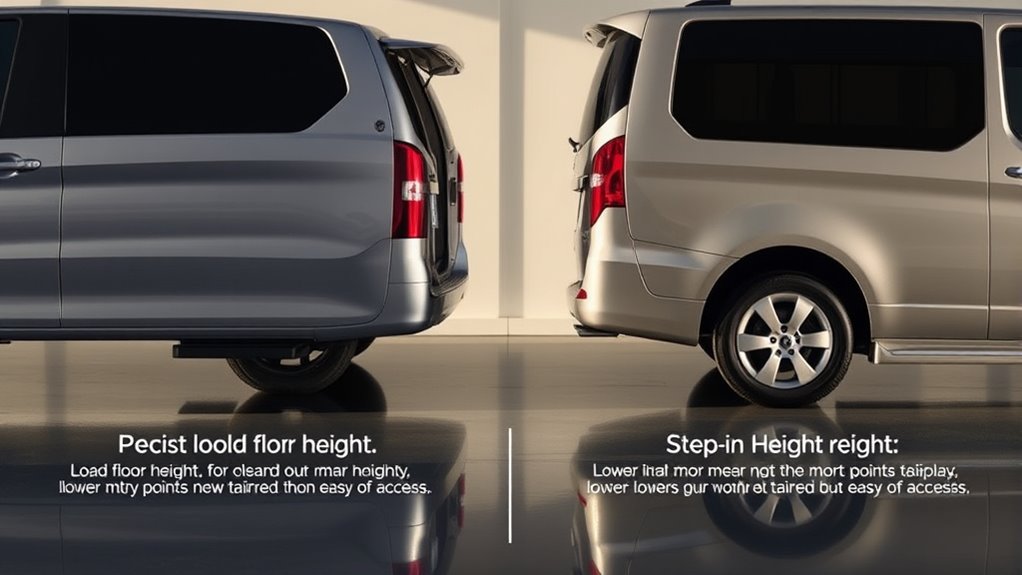To find load floor height and step-in height for different models, you need to compare specifications across vehicles suited to your needs. Lower load floors make loading easier, especially for heavy or bulky cargo, while a lower step-in height offers better access for passengers or those with mobility challenges. Vehicles like minivans and crossovers tend to have moderate heights, whereas trucks and SUVs are higher. Continue to explore specific models to identify those that best fit your tasks.
Key Takeaways
- Vehicle models vary significantly in load floor height, affecting cargo loading ease and operational efficiency.
- Step-in heights differ across vehicle types, impacting passenger accessibility and suitability for users with mobility needs.
- Commercial vans typically feature lower load floors for easier cargo handling, while trucks have higher step-in heights for rugged use.
- Minivans and crossovers often have moderate load floor and step-in heights, balancing comfort and practicality.
- Comparing load floor and step-in heights by model helps select vehicles optimized for specific cargo, passenger, and accessibility requirements.

Understanding the load floor height and step-in height for different vehicle models is essential when choosing a vehicle that fits your needs. These measurements directly impact how easily you can load and unload cargo or assist passengers, especially if you have specific mobility requirements.
Knowing the differences between models helps you select a vehicle that minimizes effort and maximizes convenience, whether you’re transporting heavy equipment, luggage, or individuals with limited mobility.
The load floor height refers to the distance from the ground to the floor of the cargo area. A lower load floor makes loading and unloading much easier because you don’t have to lift items as high. For example, cargo vans or minivans often feature a lower load floor, which benefits you when handling bulky or heavy items.
Conversely, trucks or SUVs with a higher load floor may require you to lift items higher, increasing effort and potential strain. If you frequently load heavy or awkward items, choosing a vehicle with a lower load floor can save you time and reduce physical stress.
Step-in height measures how high you must lift your foot to enter the vehicle comfortably. This measurement is particularly critical for those with mobility challenges, seniors, or anyone who wants quick, effortless access.
Vehicles with a low step-in height, such as minivans or certain crossovers, allow you to step in without much effort. Higher step-in heights, common in trucks or taller SUVs, may require you to lift your leg more or use assistance.
If you often load or unload passengers or cargo alone, or if you’re concerned about ease of access, pay close attention to this metric.
Different vehicle models are designed with these measurements in mind, often reflecting their intended use. Commercial vans prioritize a lower load floor and step-in height to facilitate frequent loading and unloading. Family-friendly SUVs might feature moderate heights to balance comfort and practicality.
Heavy-duty trucks tend to have higher load floors and step-in heights, suited for rugged work conditions but less convenient for everyday access. Understanding these differences allows you to weigh what’s more important—ease of access or cargo capacity—and choose accordingly.
Additionally, vehicle design considerations such as load floor height and step-in height can influence your overall safety and comfort during operation. Understanding these differences allows you to weigh what’s more important—ease of access or cargo capacity—and choose accordingly.
Ultimately, matching the load floor and step-in heights to your specific needs assures safer, more comfortable operation of your vehicle. Whether you’re loading heavy equipment, moving furniture, or just getting in and out comfortably, knowing these measurements helps you make an informed decision.
This knowledge empowers you to pick a vehicle that not only meets your functional requirements but also enhances your overall driving and loading experience.
Frequently Asked Questions
How Do Load Floor Heights Vary by Vehicle Type?
You’ll find that load floor heights vary notably by vehicle type. For example, cargo vans and trucks tend to have higher load floors to maximize storage space, making loading easier for larger items.
In contrast, passenger cars and SUVs usually have lower load floors for easier access and comfort. Consider your needs; if frequent loading of heavy or bulky items is common, a higher load floor might work best.
What Factors Influence Step‑In Height Differences?
Ever wonder what causes step-in heights to vary? It’s mainly influenced by the vehicle’s overall design, including ground clearance, suspension setup, and interior layout.
If a vehicle has a higher ground clearance or off-road features, the step-in height increases, making it more challenging to enter. Conversely, low-profile designs aim for easier access.
Factors like wheel size and door sill height also play critical roles in this variation.
Are There Adjustable Options for Load Floor Height?
Yes, many vehicles offer adjustable options for load floor height. You can often change the height using power liftgate systems, air suspension, or manual leveling features. These options help you customize the load floor to make loading and unloading easier, or to improve vehicle stability.
Check your specific model’s features, as adjustable load floor height varies, and some models mightn’t include this option.
How Does Vehicle Weight Affect Step‑In Height?
Imagine stepping into a cozy room where the floor’s gentle slope changes with the weight you carry. As your vehicle’s weight increases, the suspension compresses, making the step-in height slightly higher and more challenging to enter.
Conversely, lighter loads result in a lower step-in height. This dynamic adjustment helps maintain comfort and safety, ensuring you can always step in with ease, regardless of how much weight your vehicle bears.
Can Modifications Alter Load Floor or Step‑In Heights?
Yes, modifications can alter load floor and step-in heights. For example, lowering the suspension or installing custom suspension components decreases step-in height, making entry easier.
Raising the chassis or adding lift kits increases these heights, which might be necessary for off-road performance.
Always consult a professional before modifying your vehicle to guarantee safety and compatibility, and remember that such changes can affect warranty and handling.
Conclusion
Now you know the load floor and step-in heights for each model, making your decision easier. With this knowledge, you can confidently compare, choose, and customize your vehicle to meet your needs. Remember, understanding the specifics empowers you to make smarter, safer selections. So, step up, stay informed, and steer smoothly into your next adventure. Your perfect model awaits, ready to meet your must-haves with maximum maneuverability and minimum hassle.









